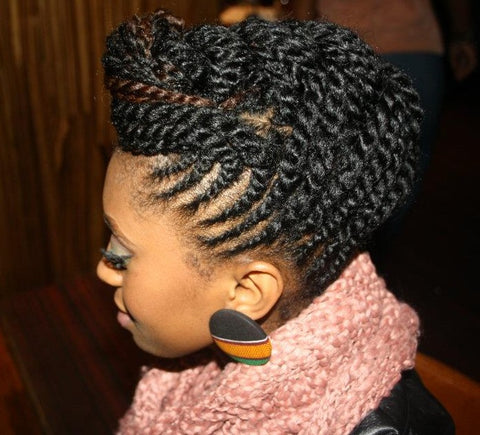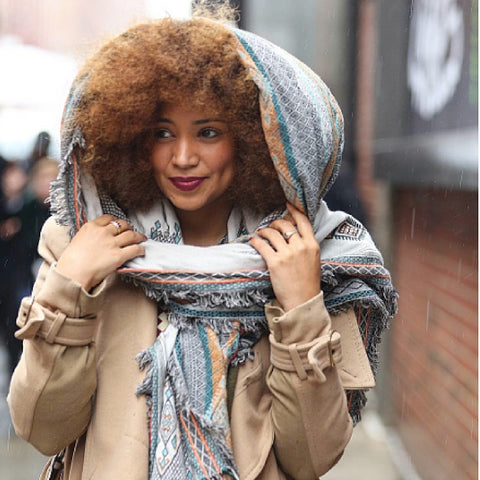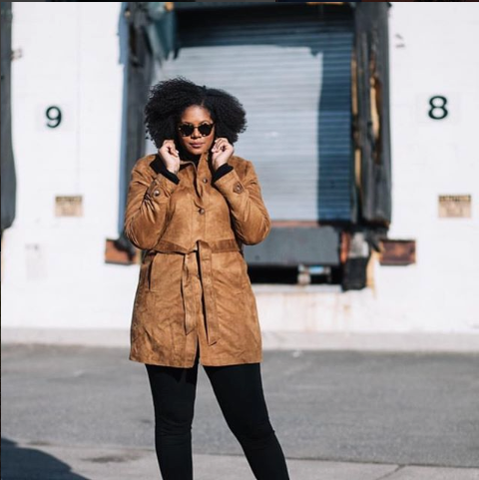
Winter makes us think of hot chocolate, twinkling lights, holiday tunes, and cozy sweaters… but it also reminds us of that horrible feeling when you take off your hat and hear static and hair strands snapping, or when you style your hair all morning and open the door to find that it’s snowing. No matter what your favorite season is, let’s just say winter is NOT curly hair-friendly.

Why is winter so bad for natural hair?
It’s a perfect storm of bad conditions. Wind and harsh cold air suck moisture out of your hair, and cause tangles. But once you’re inside, the heated air is so dry, your office can be almost as bad as sitting under a blow dryer! All this dryness accelerates frizz, breakage, and split ends, and the shock of extreme temperature changes puts additional stress on your hair. If this weren’t enough, hats, scarves, and sweaters are made from material that insulates heat, keeping your body warm- but they pull and snag on your hair, breaking strands left and right. Whether you’re inside or outside, warm or cold, it seems like there’s no escape.
But you don’t need to hibernate until the weather is warm and friendly again! With the right tips and routine, you CAN keep your hair healthy and happy throughout the winter months. In response to many questions from our NaturAll Club community members, we have compiled a guide with 10 must-know tips for winter haircare.

10 Steps to protect natural or curly hair in the winter
1. Use protective styles to your advantage.
You don't have to put your hair in braids in November and leave them in until March, but winter is NOT the time to do a wash and go everyday. Wind and cold/dry air suck moisture out of your hair, leaving it brittle, weaker, and more prone to breakage. Protective styles cut down the manipulation to your hair, which will prevent breakage, and they tuck ends and strands safely out of the way of wind and cold air.
2. Don’t put your hair in a protective style and forget about it.
Protective styles will help your hair retain more moisture than if you wore your hair out, but your hair WILL eventually dry out, even in a protective style. You need a minimal level of hair maintenance, such as applying a light moisturizer and lightweight oil to your roots every couple days to keep them moisturized. Pay attention to your hair and refresh or change your style often. We recommend changing or redoing the style every week or two.
3. Double up on nutrients!
Your hair needs protein, nutrients, and vitamins to grow and remain strong and healthy. It’s a good idea to eat healthy foods year-round for the health of your hair (and your body!) but it’s especially important in the winter as a precaution against that dry and cold air.
Here are our suggestions on foods to eat for healthy hair. Likewise, you may not be as sweaty or thirsty in the winter as you were in the summer, but be sure to drink just as much water. There is no better way to keep your hair hydrated and moisturized than providing water straight to your body.
4. Use steam to moisturize your hair.
Steam is just warm, air-born water particles, which can easily penetrate and hydrate your hair strands. This makes steam a great way to keep your hair from getting too dry in the winter. One of the easiest ways to treat your hair to steam therapy: Take a warm shower and ditch the shower cap. Just make sure you don’t leave the house with wet hair!
5. Use an anti-humectant to seal in moisture.
An anti-humectant is an oil or butter, or any product that seals moisture into your hair. Anti-humectants protect your hair from losing moisture in the dry winter air. It's especially important to use an anti-humectant after washing or moisturizing your hair. We recommend olive oil or jojoba oil, or other oils that are liquid at room temperature (no one wants their curls frozen with solidified coconut oil!)

6. Watch out for knitted hats and scarves.
The rough material will snag on natural curls and cause breakage. Don’t worry, you don’t have to let your ears freeze! Just use a thin silk cap in between your hair and hat. It may seem like an inconvenient step to take, but your hair (and your ears) will thank you! (You can do the same thing with scarves- line the outside of your scarf with a thin silk scarf to protect your hair from friction.)
7. Trim, trim, trim.
Your ends are extra vulnerable in the winter, prone to breakage and split ends. Cut off split ends as soon as you see them to keep your hair healthy. Learn more about how to prevent and get rid of split ends.
8. Stay away from heat.
Steaming your hair is good, but put away flat irons and keep your blow dryer on the cool setting for the season. These tools take moisture out of your hair, a process already accelerated by the wind and dry air outside.

9. Stay away from drying chemicals.
Many hair products include ingredients that strip oils and moisture out of your hair, which your hair can’t afford to lose in the winter! Check the ingredient list before you wash, condition, moisturize, or style your hair. Take a look at our list of ingredients to avoid in hair products.
10. You can never deep condition too much!
Seriously. Deep conditioners give your hair exactly what it needs during the winter, penetrating every strand with moisture and nutrients. As long as you use a deep conditioner with all natural ingredients like our Fresh Avocado Deep Conditioners, the more you treat your hair, the more protected it will be.

What have we missed? Comment below with your personal strategies for protecting natural hair in the winter, or with any questions!












